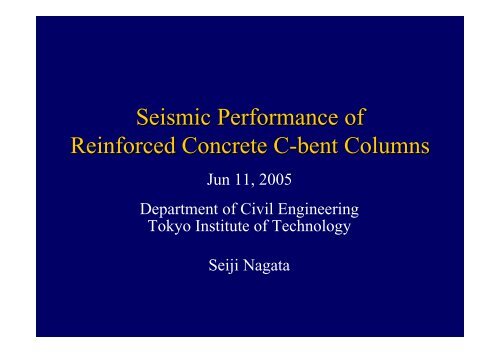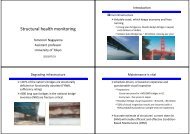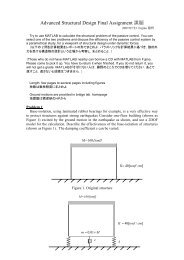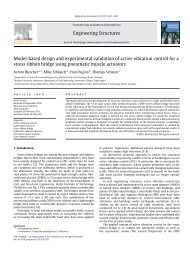Seismic Performance of Reinforced Concrete C-bent Columns
Seismic Performance of Reinforced Concrete C-bent Columns
Seismic Performance of Reinforced Concrete C-bent Columns
You also want an ePaper? Increase the reach of your titles
YUMPU automatically turns print PDFs into web optimized ePapers that Google loves.
<strong>Seismic</strong> <strong>Performance</strong> <strong>of</strong><br />
<strong>Reinforced</strong> <strong>Concrete</strong> C-<strong>bent</strong> C<br />
<strong>Columns</strong><br />
Jun 11, 2005<br />
Department <strong>of</strong> Civil Engineering<br />
Tokyo Institute <strong>of</strong> Technology<br />
Seiji Nagata
C-<strong>bent</strong> <strong>Columns</strong><br />
In urban area, there exist a large number <strong>of</strong> RC columns<br />
with the lateral beam being longer in one side than the other.<br />
Eccentric<br />
Dead Load<br />
Eccentric<br />
Dead Load<br />
Eccentricity<br />
Column<br />
Center<br />
RC Pier<br />
Steel Pier<br />
C-<strong>bent</strong> columns have a poor seismic performance!
Current Researches on C-<strong>bent</strong> C<br />
<strong>Columns</strong><br />
• Cyclic loading and shake table tests in transverse<br />
direction, Kawashima and Unjoh, 1994.<br />
• Cyclic loading tests in longitudinal direction, Tuchiya<br />
and Maekawa et al, 1999.<br />
• Cyclic loading tests in bilateral direction, Kawasima<br />
et al, 2002<br />
Longitudinal<br />
Eccentric<br />
Dead Load<br />
Transverse<br />
Lateral Force<br />
Tension Side<br />
Residual Drift<br />
Compression<br />
Side
Objectives<br />
• To clarify seismic response <strong>of</strong> RC C-<strong>bent</strong> columns<br />
under bilateral excitation, a series <strong>of</strong> hybrid loading<br />
test were conducted.<br />
• To reproduce the experimental response <strong>of</strong> RC C-<strong>bent</strong><br />
columns, a fiber element analysis was conducted
Test Specimens<br />
RC <strong>Columns</strong> were designed based on the current <strong>Seismic</strong><br />
design codes.<br />
e: Eccentricity<br />
D: Width <strong>of</strong> <strong>Columns</strong><br />
e=0<br />
1350 mm<br />
e=0.5D<br />
e=D<br />
• 1350mm<br />
Effective Height<br />
• 400mm x 400mm<br />
Square Section<br />
400 mm<br />
400 mm<br />
Axial Reinforcements 1.27 %<br />
1.35 %<br />
1.9 %<br />
Tie Reinforcements 0.79 %<br />
0.99 %<br />
1.19 %
Hybrid Loading Test on C-<strong>bent</strong> C<br />
<strong>Columns</strong><br />
Input Ground Motion: JMA Kobe Record<br />
Acceleration<br />
(m/s 2 )<br />
10<br />
0<br />
-10<br />
0<br />
Unilateral Excitation<br />
Longitudinal<br />
NS<br />
Time (s) 30 0<br />
Time (s)<br />
Bilateral Excitation<br />
EW<br />
30<br />
EW<br />
Transverse<br />
NS<br />
NS
e=0<br />
Damage after the Unilateral Excitation<br />
Damage <strong>of</strong> columns at the eccentric completion side<br />
e=D<br />
e=0.5D<br />
NS<br />
NS<br />
NS<br />
Separation <strong>of</strong> the<br />
covering concrete<br />
The damage increases as the eccentricity increases.
Displacement (mm)<br />
e= = 0.5D<br />
50<br />
0<br />
NS<br />
<strong>Seismic</strong> Response under<br />
the Unilateral Excitation<br />
Residual<br />
Drift<br />
e= D<br />
NS<br />
-2<br />
-50<br />
0 30<br />
Time (sec)<br />
Drift (%)<br />
The residual drift increases as the eccentricity increases.<br />
2<br />
0<br />
Prescribed<br />
Displacement (mm)<br />
Drift (%)<br />
0 1 2<br />
40<br />
20<br />
0<br />
-20<br />
1.2% Drift<br />
2.6% Drift<br />
-1<br />
-2<br />
-40<br />
0 10 20 30 40<br />
Residual Drift in the eccentric<br />
compression side (mm)<br />
2<br />
1<br />
0<br />
Drift (%)
Hybrid Loading Test under<br />
the Bilateral Excitation<br />
Residual Drift<br />
After Loading<br />
Before Loading<br />
NS<br />
EW
Effect <strong>of</strong> Bilateral Excitation<br />
Unilateral Excitation<br />
Bilateral Excitation<br />
e=D<br />
NS<br />
Separation <strong>of</strong> the<br />
covering concrete<br />
NS<br />
EW<br />
Bilateral excitation results in more extensive damage
Unilateral<br />
NS<br />
Bilateral<br />
NS<br />
Effect <strong>of</strong> Bilateral Excitation<br />
EW<br />
Dislacement (mm)<br />
Dislacement (mm)<br />
60<br />
40<br />
20<br />
0<br />
-20<br />
-2<br />
-40<br />
0 5 10 15 20<br />
Time (sec)<br />
25 30<br />
20<br />
0<br />
0<br />
-20<br />
-40<br />
3.9 % Drift<br />
2.9 % Drift<br />
Unilateral Excitation<br />
-60<br />
-80<br />
0 5 10 15 20 25 30<br />
Time (sec)<br />
e=D<br />
Bilateral Excitation results in larger residual drift.<br />
Effect <strong>of</strong> bilateral excitation is important in evaluation <strong>of</strong> a residual drift<br />
4<br />
2<br />
0<br />
-2<br />
-4<br />
Drift (%)<br />
Drift (%)
Fiber Model <strong>of</strong> the RC C-Bent C<br />
<strong>Columns</strong><br />
Torsinal Stiffness<br />
T=GJφ<br />
Plastic<br />
Hinge<br />
Rotational<br />
Spring<br />
Fiber Element<br />
<strong>Concrete</strong><br />
Stress (MPa)<br />
Hoshikuma et al. Model<br />
Covering <strong>Concrete</strong><br />
Core <strong>Concrete</strong><br />
Strain<br />
Sakai Model<br />
T : Torsional Moment<br />
φ : Curvature<br />
G: Shear modulus<br />
J : Torsional moment <strong>of</strong><br />
inertia<br />
Stress<br />
Reinforcements<br />
E s2<br />
E s<br />
Menegotto and Pint Model<br />
Strain
Fiber Element Analysis<br />
e=0<br />
Analysis<br />
Experiment<br />
Displacement (mm)<br />
Longitudinal<br />
70<br />
0<br />
-20<br />
0 10 20<br />
Time (Sec)<br />
Drift (%)<br />
Displacement (mm)<br />
4<br />
2<br />
0<br />
40<br />
0<br />
Transverse<br />
-50<br />
0 10 20<br />
Time (Sec)<br />
2<br />
Drift (%)<br />
0<br />
-2
Fiber Element Analysis<br />
e=0.5D<br />
Analysis<br />
Experiment<br />
Displacement (mm)<br />
Longitudinal<br />
70<br />
0<br />
-30<br />
-2<br />
0 10 20<br />
Time (Sec)<br />
Drift (%)<br />
Displacement (mm)<br />
4<br />
2<br />
0<br />
30<br />
0<br />
Transverse<br />
-4<br />
-60<br />
0 10 20<br />
Time (Sec)<br />
2<br />
0<br />
-2<br />
Drift (%)
Fiber Element Analysis e=D<br />
Analysis<br />
Experiment<br />
Displacement (mm)<br />
60<br />
Longitudinal<br />
0<br />
-40<br />
-2<br />
0 10 20<br />
Time (Sec)<br />
4<br />
2<br />
Drift (%)<br />
0<br />
Displacement (mm)<br />
20<br />
0<br />
Transverse<br />
-4<br />
-70<br />
0 10 20<br />
Time (Sec)<br />
The analysis correlates the accumulation <strong>of</strong> residual drift<br />
in the eccentric compression side.<br />
0<br />
Drift (%)<br />
-2
Conclusions<br />
• Extensive failure occurs at the eccentric compression<br />
side under both the unilateral and the bilateral<br />
excitations. This results in a large residual displacement<br />
in the eccentric compression side.<br />
• The failure and the residual displacement under the<br />
bilateral excitation are more extensive than those under<br />
the unilateral excitation.<br />
• A fiber analysis correlates the accumulation <strong>of</strong> residual<br />
drift in the eccentric compression side. However, the<br />
analysis underestimates the residual drift.
Thank you for your attention












